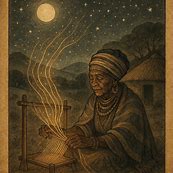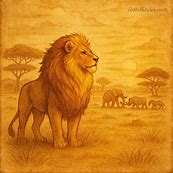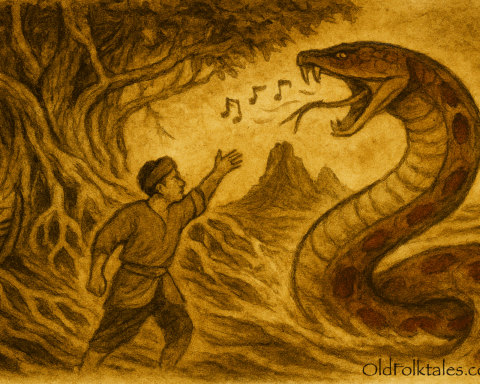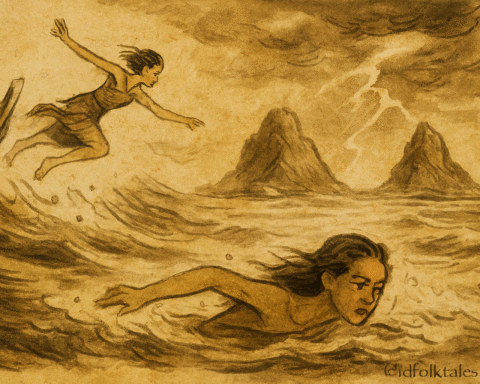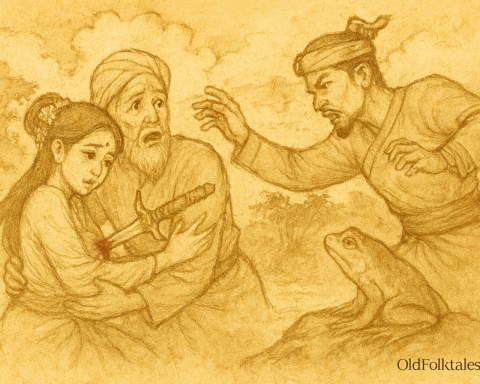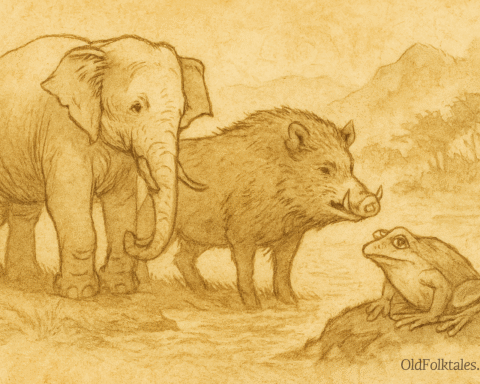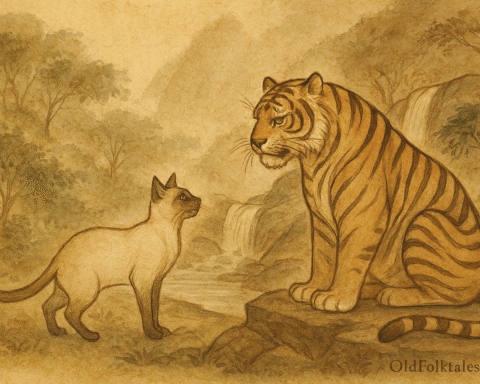In a quiet valley where the wind carried the songs of the ancestors, there once lived an old woman named Nomvula. Her back was bent with age, and her hair was as white as mountain mist, but her hands remained steady and sure. She was the finest weaver in her village, known for her tapestries that shimmered like morning dew and told stories no words could hold.
Nomvula lived alone in a round hut at the edge of the settlement. Her husband had long passed, and her children had moved away to seek work in faraway towns. Yet every evening, when the sun dipped below the hills, she would sit before her loom by the flickering fire and begin to weave.
She wove with colours drawn from the earth and sky deep indigo from river stones, golden thread from dry grass, and black dye made from ash and soot. Each thread carried a story. She said that when she wove, she was speaking to the ancestors, and that they answered her in the rhythm of her hands.
Don’t miss out: Read more Southern African folktales
The villagers often came to watch her. Some thought her strange, for she spoke softly to the cloth as she worked, whispering words no one else could hear. Others said she was blessed by the gods of creation. But Nomvula only smiled. “The night listens,” she said. “It waits for what I weave.”
As years passed, drought struck the land. The rivers thinned, the soil cracked, and the sky remained cloudless. The people grew restless and frightened. “The heavens have turned away,” the elders murmured. “We have lost the favour of the spirits.”
Still, Nomvula wove. She did not complain or despair. Instead, she began a new tapestry unlike any she had made before. She worked only at night, under the pale light of the moon. The neighbours could see her hut glowing faintly through the darkness, as if the fire within burned with a strange blue flame.
When asked what she was making, Nomvula answered, “I am weaving a prayer for the sky.”
Her loom creaked softly as she worked, and her fingers moved like wind over grass. She wove swirling shapes of black and silver, gold and blue, filling the cloth with patterns that seemed to breathe and move like water. The threads shimmered with such life that those who glimpsed them felt their hearts lift.
One night, as she worked, Nomvula felt a presence beside her. The air grew cool and bright. She looked up and saw a tall figure dressed in light, its face calm and radiant. It was Nomhle, one of the ancient sky spirits who watched over the world.
“Old mother,” said the spirit, “your weaving sings louder than words. The gods have seen your work and wish to know its purpose.”
Nomvula bowed her head. “I weave so that my people may remember beauty even in sorrow. I weave the night sky to remind them that darkness, too, can shine.”
The spirit smiled. “Your hands carry the heart of creation. When you finish your tapestry, the heavens themselves will wear it.”
Nomvula continued to weave through the following nights. Her body grew weak, but her spirit glowed brighter. When she placed the final thread, a gentle wind rose and lifted the tapestry from her loom. It shimmered, twisting and curling upward like smoke. The villagers rushed from their huts as the cloth ascended into the sky.
They watched as it spread wide, covering the heavens in a vast web of glittering light. Stars bloomed where her threads had passed, and constellations took shape from her patterns. The dark sky became her canvas, and the stars her eternal stitches.
When dawn came, Nomvula was gone. In her hut lay only her old loom and a single strand of silver thread that pulsed faintly like a heartbeat. The villagers wept, but they also sang, for they understood that she had not died, she had simply joined her creation.
From that night on, the people looked to the heavens and called it Nomvula’s Cloth. Children learned to trace her woven stories among the stars: the lion that guards the moon, the fish that swims between clouds, and the river of light that flows across the sky.
Each night, when the wind whispered through the valley, it sounded like the creak of her loom, and people said, “The old weaver is still at work.”
Generations passed, but her tale never faded. Parents told their children, “When you create with love and faith, your work lives beyond your hands. It becomes part of the world.”
And so, even now, when the night sky shines over the Xhosa lands, elders remind the young, “Those are not just stars. They are the stitches of Nomvula’s spirit.”
Moral Lesson
True creativity is a form of prayer. When we create with love and purpose, our work becomes part of something eternal.
Knowledge Check
Who was Nomvula in The Woman Who Wove the Night Sky?
Answer: She was an elderly Xhosa weaver whose tapestries carried stories and prayers.Why did Nomvula begin weaving at night?
Answer: She wanted to weave a prayer for the sky to bring hope during a time of drought.What made her final tapestry special?
Answer: It was so beautiful and powerful that the gods lifted it into the heavens and turned it into the stars.What message did Nomvula share through her weaving?
Answer: That even in darkness, beauty and light can be found.What happened to Nomvula at the end of the story?
Answer: She vanished after finishing her tapestry, becoming one with the stars she created.What lesson does this Xhosa folktale teach?
Answer: Creativity and faith can leave a legacy that outlives us and brings light to others.
Source: Xhosa folktale, South Africa. Compiled by Nontsizi Mgqwetho in Songs and Stories of the Ancestors (1940).
